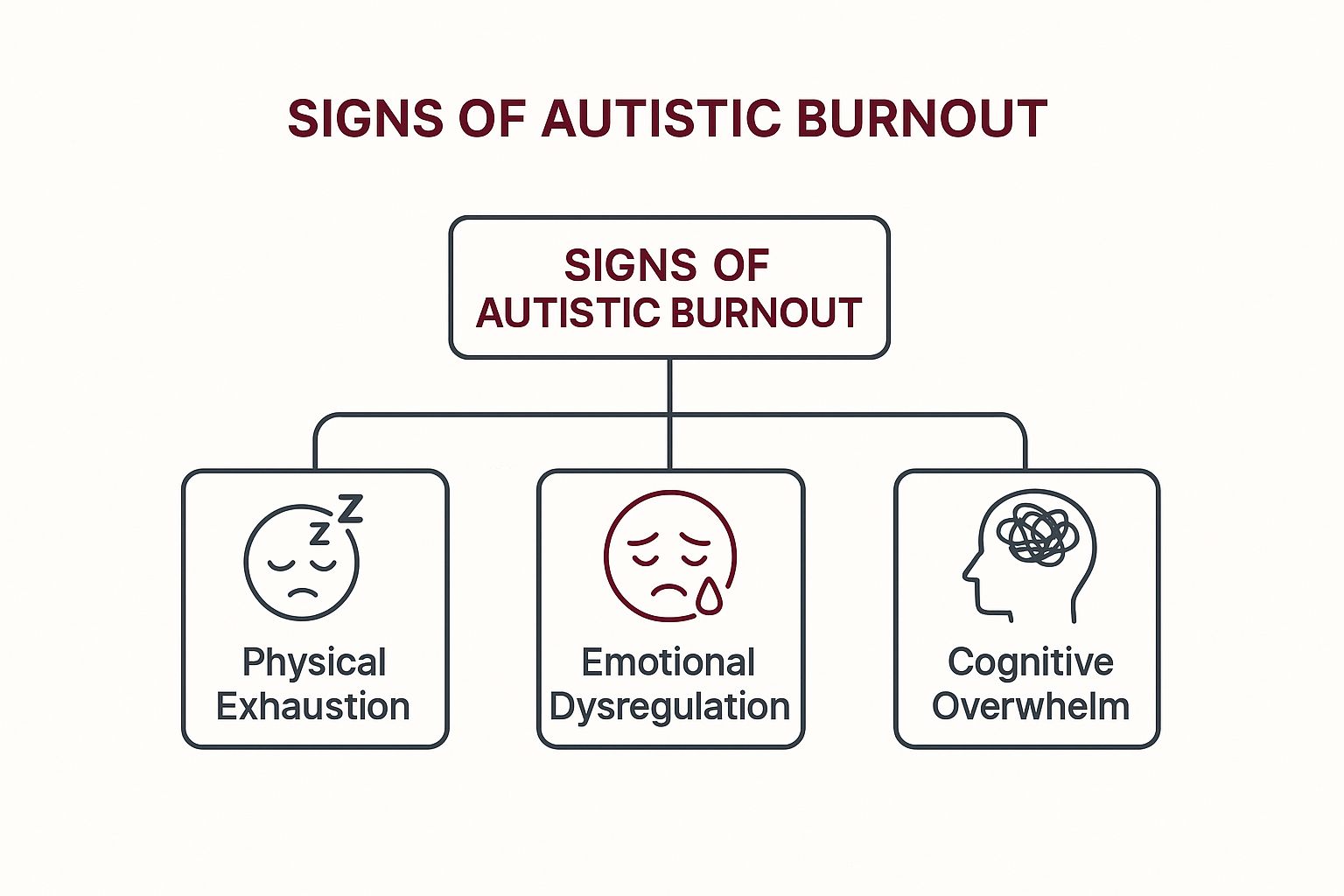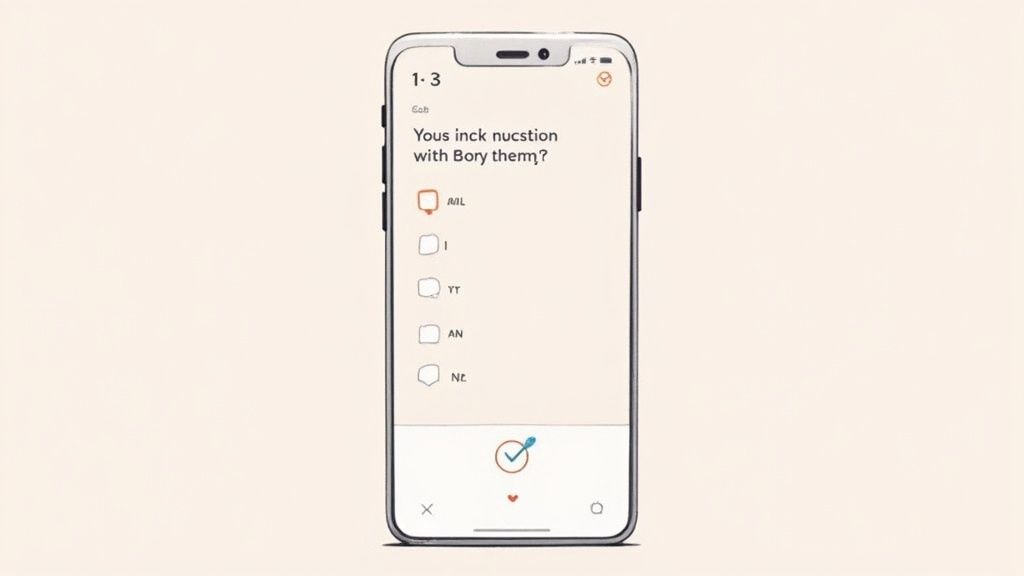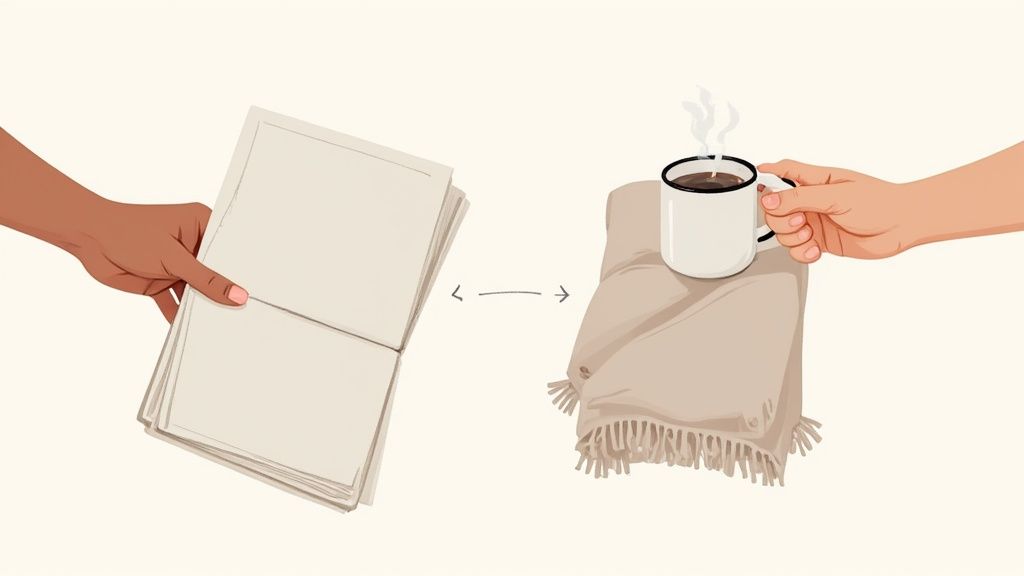Before you jump into an autistic burnout quiz, it’s a good idea to get a feel for what it’s actually measuring. This isn't about just feeling tired; it's a state of profound, bone-deep exhaustion that can seriously disrupt your life and even the skills you take for granted. This self-assessment is really a tool to help you see and name the signs within your own experience.
What Does Autistic Burnout Actually Feel Like?
Think of your daily energy like a phone battery. Most people get a full recharge overnight. But for an autistic person, just getting through the day in a world not designed for them is like running dozens of power-hungry apps in the background. Things like masking your traits, filtering out sensory overload, and trying to decode confusing social cues are a constant drain.
With all that going on, the battery never seems to make it back to 100%.
That analogy really gets to the core of autistic burnout. It isn't just a bad mood or a temporary slump. It's a state of chronic exhaustion that completely depletes your internal resources, impacting everything from your job performance to your ability to tolerate noise. It’s very different from other kinds of exhaustion, and you can dive deeper into the distinctions in our guide on autistic burnout vs. regular burnout.
The Impact on Your Skills and Senses
When burnout really takes hold, it’s common to feel like you’ve lost skills you once had. Executive functions—the mental processes for planning, organizing, and just starting a task—can feel almost impossible to access.
You might also start noticing:
- Heightened Sensory Sensitivity: Sounds that were annoying before might now feel physically painful. Lights can seem blindingly bright, and the tag on your shirt could become unbearable.
- Reduced Social Capacity: Simply having a conversation or being around people can feel overwhelming, often leading you to withdraw and isolate yourself.
- Emotional Dysregulation: You might find yourself having more frequent meltdowns or shutdowns because your ability to manage your emotions has worn dangerously thin.
Autistic burnout is recognized as a significant mental health challenge characterized by chronic exhaustion, loss of function, and reduced tolerance to sensory stimulus.
This is much more than a bad week. Research suggests that autistic burnout typically lasts for three months or even longer, and it often first appears during the already-turbulent adolescent years. This really highlights its potential for long-term impact on a person's well-being. Discover more insights about these findings.
Keeping this lived experience in mind is crucial. It helps you see the quiz not just as a simple checklist, but as a meaningful tool for validation and self-discovery.
Take the Autistic Burnout Self-Assessment Quiz
This autistic burnout quiz is a private, non-judgmental space for self-reflection. It’s not a diagnostic tool, but it can be a helpful guide to connect with your own experiences and maybe put a name to what you've been feeling.
Take a moment to answer each question based on how you've felt over the past few months. The most important thing is to be honest with yourself—there are no right or wrong answers here. The goal is simply to paint a clearer picture of where you are right now.
How to Take the Quiz
For each statement below, pick the response that fits you best. Just keep a running tally of your points as you go through the list. You'll use your total score in the next section to get a better sense of what your results might suggest.
- Never = 0 points
- Sometimes = 1 point
- Often = 2 points
- Almost Always = 3 points
The Autistic Burnout Self-Assessment
1. I feel a deep, persistent sense of physical exhaustion that sleep doesn't seem to fix.
(Never / Sometimes / Often / Almost Always)
2. My ability to handle everyday tasks like chores or emails feels completely depleted.
(Never / Sometimes / Often / Almost Always)
3. I have become more sensitive to sounds, lights, or textures than I used to be.
(Never / Sometimes / Often / Almost Always)
4. Social interactions, even with people I like, feel draining and require significant recovery time.
(Never / Sometimes / Often / Almost Always)
5. I find myself withdrawing from social situations more frequently just to conserve energy.
(Never / Sometimes / Often / Almost Always)
6. My ability to plan, organize, and start tasks (executive functioning) has noticeably declined.
(Never / Sometimes / Often / Almost Always)
7. I have lost skills or abilities that used to come easily to me (e.g., verbal communication, problem-solving).
(Never / Sometimes / Often / Almost Always)
8. I feel less able to "mask" my autistic traits or pretend to be neurotypical.
(Never / Sometimes / Often / Almost Always)
9. My emotional responses feel more intense or harder to regulate, leading to meltdowns or shutdowns.
(Never / Sometimes / Often / Almost Always)
10. My memory and ability to concentrate have worsened.
(Never / Sometimes / Often / Almost Always)
11. I feel detached or disconnected from my own life and identity.
(Never / Sometimes / Often / Almost Always)
12. I have lost interest in my hobbies or special interests.
(Never / Sometimes / Often / Almost Always)
13. Simple decisions feel overwhelming and impossible to make.
(Never / Sometimes / Often / Almost Always)
14. I experience more physical symptoms like headaches, stomach issues, or general aches.
(Never / Sometimes / Often / Almost Always)
15. I feel like I'm constantly operating with a shorter fuse and less patience for everything.
(Never / Sometimes / Often / Almost Always)
Remember: This is a tool for self-discovery, not a replacement for professional medical advice. Its real purpose is to validate your experiences and give you a starting point for conversation and action.
Once you’ve answered all the questions, add up your points to get your total score. The next section will walk you through how to interpret that score in a supportive, practical way.
How to Interpret Your Quiz Results
So you've finished the quiz. That score you're looking at is a personal snapshot—a way to put a name to what you've been feeling and connect it to a clearer framework. It's really important to remember this isn't a clinical diagnosis. It’s a guide for self-discovery. The whole point is to give you language for your experiences and, maybe most importantly, to validate them.
Think of your score as a personal energy gauge. A lower number might mean you’re managing your resources well right now. A higher score, on the other hand, can be a powerful confirmation that your exhaustion is real and significant. It's a signal that it's time for some serious rest and support.
Understanding Your Score Range
Let's break down what your total score might be telling you. Each range offers a different perspective and can help you figure out what to do next to start feeling better.
-
Low Likelihood (0-15 points): A score in this range suggests you likely have some good energy management strategies in place. You might hit a wall with stress from time to time—who doesn't?—but the core signs of burnout probably aren't a constant in your life.
-
Moderate Likelihood (16-30 points): This score is a flag. It could mean you’re dealing with several key symptoms of autistic burnout. You might be feeling the weight of masking, sensory overload, or social exhaustion. Your reserves are probably running low.
-
High Likelihood (31-45 points): A score this high is a critical signal. It strongly suggests you're experiencing severe and persistent symptoms that line up with autistic burnout. Your mind and body are telling you they need immediate, intentional rest and a major reduction in demands.
This infographic does a great job of breaking down the core pieces of burnout that a quiz like this often measures.
As you can see, burnout hits you physically, emotionally, and cognitively. It really is a whole-body experience, not just something "in your head."
To give you a clearer picture, here’s a quick summary of what the different score ranges might mean for you and where you could focus your energy.
Understanding Your Burnout Score
| Score Range | Potential Interpretation | Suggested Focus |
|---|---|---|
| 0-15 | You are likely managing your energy well, with few persistent signs of burnout. | Proactive self-care and maintaining your current routines to prevent future exhaustion. |
| 16-30 | You may be on the edge of burnout or experiencing moderate symptoms. | Identifying key stressors and introducing intentional rest and recovery periods into your week. |
| 31-45 | You are likely in a state of severe autistic burnout and need immediate support. | Drastically reducing demands, prioritizing deep rest, and seeking external support. |
No matter where you landed, this score is a starting point. It’s a piece of information you can use to advocate for yourself, make changes, and begin the path toward recovery.
Identifying Common Burnout Triggers in Daily Life
Knowing your quiz score is a great start, but the real work begins when you connect that score to what’s happening in your everyday life. The quiz questions are designed to shine a light on the stressors that often fly under the radar—the hidden energy costs of living in a world not built for the autistic brain.
Imagine your energy is a bank account. Every small adjustment you make to fit neurotypical expectations is like a small withdrawal. One or two won't break the bank, but over time, they add up. Eventually, you’re left with the deep, bone-weary exhaustion of burnout. Pinpointing these triggers is your first step to stopping the drain.
The Cumulative Cost of Masking
One of the biggest culprits is masking, which is essentially camouflaging autistic traits to fit in. This isn't just "acting normal"—it's a constant, conscious effort that burns an incredible amount of mental energy.
Some common examples of masking that can lead to burnout are:
- Forcing eye contact during a conversation, even when it feels deeply uncomfortable or makes it hard to focus.
- Suppressing stims, like hand-flapping or rocking, when you’re in public or at work.
- Pretending to understand a joke or complex social cue just to avoid looking different.
- Mimicking neurotypical body language and facial expressions to seem engaged or appropriate in social settings.
Each of these acts might seem small on its own, but they create a cumulative stress load. The daily pressure to perform this version of neurotypicality is a direct path to autistic burnout.
This pressure can feel especially intense in places that don't offer much understanding or accommodation, like the workplace. Employment statistics show just how tough it can be. Globally, unemployment for autistic people is alarmingly high. In the United States, for example, only about 21% of autistic adults have full-time jobs, a reality that adds a huge layer of stress. You can learn more about the employment challenges for autistic people and how they contribute.
Sensory and Social Overload
Beyond masking, the world can feel like a constant assault on the senses. A noisy, open-plan office isn't just a minor annoyance; for an autistic person, it can be a non-stop, draining sensory attack.
The same goes for social demands. Trying to navigate unstructured parties or constantly meet neurotypical social expectations requires intense focus, leaving very little energy for anything else. The key is to start seeing these situations for what they are—major stressors, not personal failings. That shift in perspective is crucial for preventing the next burnout cycle.
Practical Strategies for Burnout Recovery and Prevention
Realizing you're in burnout after taking a quiz is the first step, but what comes next? Recovery isn't about powering through. It's about intentionally and strategically reducing the very demands that drained your battery in the first place. This means learning to build a life that works with your autistic brain, not against it.
The path forward is all about making compassionate, practical changes that restore your energy reserves. Think of it less like a sprint back to "normal" and more like building a new, more sustainable way of living.
Strategic Energy Management
Your first priority has to be stopping the energy drain. This means getting real about what activities cost you the most and consciously reducing them. A great place to start is with masking. Allowing yourself to stim freely at home or giving yourself permission to skip eye contact on a video call are huge ways to conserve precious energy.
Creating a sensory-friendly space is another game-changer. This might look like:
- Using noise-canceling headphones to create a bubble of quiet.
- Switching to dimmer, warmer lighting to reduce visual strain.
- Wearing comfortable, seamless clothing that doesn't irritate your skin.
These aren't minor tweaks; they dramatically lower the sensory input your brain has to process every single day, leaving more energy for you.
The Power of Meaningful Rest
True rest is so much more than sleep. For an autistic person in burnout, meaningful rest is about engaging in low-demand activities that genuinely recharge you, not just fill time. It's about giving yourself permission to do absolutely nothing without feeling guilty about it.
Recovery means embracing activities that fill your cup, not just rest your body. This often means unapologetically dedicating time to your special interests, which can be profoundly restorative.
This is the exact opposite of mindless doomscrolling or having the TV on in the background. It's an active choice. Exploring different mindfulness activities can also be a fantastic tool for lowering stress and reconnecting with yourself when you're feeling depleted.
Building Your Support System
You don't have to go through this alone. Connecting with other autistic people can be incredibly validating. Suddenly, you're in a space where you don't have to explain or justify your experiences. Online forums or local groups are great places to share strategies and just feel understood.
Finding neurodiversity-affirming professionals is also a critical piece of the puzzle. A therapist who truly gets autistic burnout can offer guidance that actually fits your needs. It can also be empowering to focus on practical skills; learning about social skills for autistic adults from a neurodivergent-friendly perspective can help lower social anxiety and save energy. This support network is fundamental to lasting recovery and preventing burnout in the future.
Your Questions About Autistic Burnout Answered
After taking a quiz and spending some time reflecting, it's completely normal to have more questions popping up. This is a space for clear, straightforward answers to some of the most common concerns we hear. The goal is to help you feel more confident and grounded in your understanding.
Is Autistic Burnout the Same as Depression?
While they can certainly look alike on the surface and even overlap, they are two distinct experiences. Depression is a mood disorder, often defined by a persistent feeling of sadness, emptiness, or numbness.
Autistic burnout, however, is a state of profound, full-body exhaustion and a loss of skills, directly caused by the chronic stress of trying to navigate a world not built for you.
They can absolutely co-occur, which makes getting the right kind of support so crucial. A professional evaluation can help untangle the symptoms and point you toward the most effective support for one or both conditions.
How Long Does Autistic Burnout Last?
This is a tough one because there’s no set timeline for recovery. How long it lasts really depends on how severe the burnout is and, most importantly, your ability to significantly reduce demands and access deep, meaningful rest.
For many, recovery isn't a quick fix but a long-term process that can last for months or even years. The focus should be less on "bouncing back" and more on making sustainable changes to your environment, routines, and support systems to prevent it from happening again.
This autistic burnout quiz is a self-assessment tool designed for reflection and education only. It is not a substitute for a professional evaluation from a qualified healthcare provider familiar with autism. Use your results to start a more informed conversation.
What Is the Difference Between Burnout and a Shutdown?
A helpful way to think about this is in terms of timescale. A shutdown is an acute, short-term response to being completely overwhelmed in the moment. During a shutdown, an autistic person might temporarily lose the ability to speak or interact as their brain essentially hits the emergency brake to protect itself from more input.
Burnout, on the other hand, is a chronic, long-term state of exhaustion that grinds down your entire capacity to function over weeks, months, or longer. Frequent shutdowns can be a major warning sign that you're on the path toward burnout.
Supporting a loved one through these states requires a lot of patience and understanding. Our guide on how to help your partner with Asperger's offers valuable insights that can apply to many different relationships.
At the Sachs Center, we specialize in providing clarity through expert telehealth evaluations for Autism and ADHD. If your quiz results have raised questions, our compassionate team is here to provide the answers and support you need on your journey. Book your diagnostic evaluation today.



